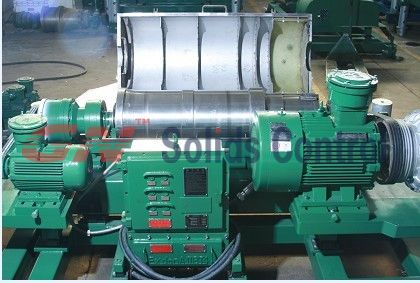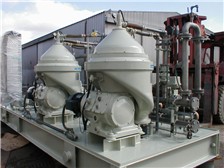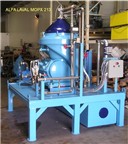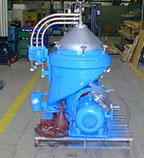In Ohio, Algaeventure Systems advises that, today, they are releasing an RFP targeting the nation’s leading algae producers to act as demonstration sites for its SLS Industrial algae dewatering technology under its 2009 DOE ARPA-E grant.
Why is that important? Well, if you’ve somehow figured out how to grow algae for biofuels on an industrial scale and at an industrial rate – no small achievement – and your algae is cost-effectively produced and contains just the right mix of carbs, proteins and lipids for your target array of must-have products at everyday low prices…you’ve still got one small problem left.Just one minor detail - one teency thing. In fact, its so small, it’s microscopic. The algae, that is – single celled creatures that they are that grow to no more than about a 1 percent concentration before you need to harvest – in fact, 0.1 percent concentrations are in many cases closer to the norm.
So, you have either get the water out of the algae or the algae out of the water. Or else, you have a whole lotta watta – that is to say, as much as a thousand gallons of water for every gallon of algae.
The little guys are too small for traditional means of filtration, centrifuging, or solvent extraction (typically, using hexane). It’s more than “the mother of all challenges”, its a barrier that, in itself, could prevent algal biofuel from reaching commercial parity with $80 crude oil. General Atomics has pegged the current cost of algae harvesting at $0.80 to $1.60 per gallon. As they say, a tad high.
So who’s been working on the problem and what have they come up with? The solutions group into a few categories:
One field looks at milking (or otherwise crushing the cell) while the the algae is still in the water, counting on the fact that oil and water will phase separate and allow the oil to be economically collected. Another aims to get the algae to concentrate, and the other aims to force the water and algae to separate, and thereby move the water away from the algae.
Let’s take a look.
More on Algaeventure Systems and its RFP
The RFP is an opportunity for AVS and potential demonstration sites to test and evaluate an innovative technology on a large-scale, under real-world conditions.
AVS will consider demonstration sites across a range of algae growth configurations and will select sites based upon production output, type of growth system, algae species and regional location. Described by ARPA-E as a “potentially transformative innovation…of the very highest scientific and technical merit,” the low-energy solid-liquid separation system aims to reduce the energy cost of dewatering microalgae by 90%.
AlgaeVenture Systems reported in 2009 that a prototype of its technology has reduced algae dewatering costs to $1.92 per ton (about $0.007 per gallon), from a $3.19 per gallon cost achieved with centrifuges and will reduced the cost from $875 per ton to a dramatic low cost of $1.92 per ton.
(Interested in the RFP? Contact Dylan Meister at 937-645-4693 or email dmeister@algaevs.com)
OriginOil’s Single-Step Extraction and Live Extraction
OriginOil’s Single Step Extraction is currently implemented in the field at MBD Energy’s James Cook University site in North Queensland, Australia. It can be deployed in two ways: dewatering only for conversion of the entire algae mass to a refinable bio-oil, or full separation of lipids and biomass to create more valuable products along with fuels.
Live Extraction is OriginOil’s process for extracting very high quality lipids on a continuous basis from algae that heals after it has been ‘milked’ of its oil content. Live Extraction is in a prototype stage and further developments are expected in 2011.
Last week, the company announced that it will focus on its algae extraction technology platform to the exclusion of a number of other technologies for, among other things, algal growth.
New Oil Resources and thermal depolymerization.
Last October, New Oil Resources announced that it has developed a process that uses hot, pressurized water to treat the biomass in a process commonly referred to as hydrothermal liquifaction or thermal depolymerization.
According to the research team, “algae can be processed without dewatering and all the carbon is converted to fuels, not just the fatty oils.” The group said that immediate applications include processing municipal sewage sludge, processing waste streams from the ethanol industry and converting algae to fuel.
The Newoil process is reporting that 70% to 80% of the energy in the feedstock is being returned in the final products. The remaining 20% to 30% of the energy is used to run the process.
Unitel and its sweetwater slurry
Last July, Unitel Technologies advised that the company has filed a patent application for a new technology for making biofuels from microalgae. The process involves minimal dewatering, and completely bypasses the energy intensive drying and oil extraction steps.
In the Unitel process, the feedstock – a slurry or “soup” of water and cultivated algae (1% to 20% by weight) is continuously treated in a special hydrolysis reactor to yield 1) a fatty acid product, 2) a “sweet” water stream containing glycerol and other solubles, and 3) deoiled algal biomass. A small fraction of the fatty acid product is fed back into the reactor as catalyst. The nutrient rich “sweet water” is recycled into the algae propagation tanks, where the carbon in the glycerol serves to promote the growth of phytoplankton.
The deoiled biomass (consisting primarily of proteins and carbohydrates) is dried as a food ingredient for animal consumption. The algal fatty acid product is catalytically decarboxylated and converted into paraffinic hydrocarbons (alkanes), followed by mild hydrocracking and hydroisomerization to make biojet fuel comprised of C10-C15 branched paraffins.
Evodos and low-cost centrifuging
A year ago last September, Evodos said that it had developed a very energy-efficient centrifuge to extract algae from water. The low energy consumption allows for a positive energy balance, paving the way for large-scale production of biodiesel from algae, according to company reports. Leading scientists are very excited about this innovation.
The Evodos technology consists of two steps: first, most of the water in which the algae are growing is removed and next the algae are transformed into a dry paste. The Evodos technology enables the extraction of a solid algae cake with a dry solid content of 31.5%. Tests have been conducted to date with Nannochloropsis.
The University of Michigan’s big algal bypass
Last September, a UM research team published, in Energy & Fuels, details of a two-step, catalyst-free algal biodiesel production process, using wet algal biomass and bypassing the drying and solvent extraction steps.
The researchers wrote: “In the first step, wet algal biomass (ca. 80% moisture) reacts in subcritical water to hydrolyze intracellular lipids, conglomerate cells into an easily filterable solid that retains the lipids, and produce a sterile, nutrient-rich aqueous phase. In the second step, the wet fatty acid-rich solids undergo supercritical in situ transesterification (SC-IST/E) with ethanol to produce biodiesel in the form of fatty acid ethyl esters (FAEEs).”
The University of Michigan’s pressure-cookin’, bio-oil makin’ recipe for makin’ money from low-fat algae
In Michigan, researchers at the University of Michigan are investigating a recipe to pressure-cook algae at 300 degrees for 30 minutes, and thereby break down oils, proteins and carbohydrates into a bio-oil, which can be upgraded into fuel.
The $2 million project, funded by the National Science Foundation under the American Recovery and Reinvestment Act, is aimed at producing acceptable fuel yields from low-oil content algae strains, as well as eliminating the need for water extraction in algal fuel production.
Plus, some stealthy or embryonic projects to keep an eye on.
New Mexico State and the Air Force
The US Air Force has granted New Mexico State University $2.364 million towards algal research to study better ways to grow algae and refine its oil while working with the University of Central Florida to determine the effects of algae-based fuel on jet engines. Project researchers say they must increase the biomass weight of algae, increase the lipid content and focus on harvesting and extraction techniques.
A mystery at Heliae
In November, Heliae tapped ex-BioFuel Energy COO Dan Simon as CEO. What does SImon say? Simon says that Phoenix-based Heliae, which just opened a state-of-the-art research and development facility located in Gilbert, is undertaking scaled testing of a patent-pending extraction process that they can’t say anything about. One to watch even if we don;t know a darm thing about it.
Solix and the sonic option
Noise usually destroys concentration, but turns out that a team from the Los Alamos National Laboratory went the other way on that. According to reports that came out at the time Solix signed a research agreement with LANL, “Los Alamos’ acoustic-focusing technology generates ultrasonic fields that concentrate algal cells into a dense sludge and extract oil. Solix hopes that combining the concentration and extraction steps into one process will eliminate the need for centrifuges and solvents (traditional extraction methods) — and at the same time, significantly cut the cost of producing the biofuel.”
Over at the National Alliance for Advanced Biofuels and Bioproducts (NAABB)
Led by the Donald Danforth Plant Science Center (St. Louis, MO), NAABB is integrating resources from companies, universities, and national laboratories to overcome the critical barriers of cost, resource use and efficiency, greenhouse gas emissions, and commercial viability. They landed a $50M foundational grant from the DOE last year, and have been gearingup on a variety of research fronts.
Principal investigator of the NAABB project, Jose Olivares, said: “In harvesting and oil extract, we are starting with five technologies and hop to focus down to one or two for harvesting the algae in a very energy efficient manner, and that are very cost effective.”
The Digest’s Take
A whole lotta watta has spurred a whole lotta innovation – but more contenders than champions here. AVS’ demonstration may well be a game-changer in the nearer term – watch OriginOil’s Australia project with MBD too.
source: biofuelsdigest.com/bdigest













